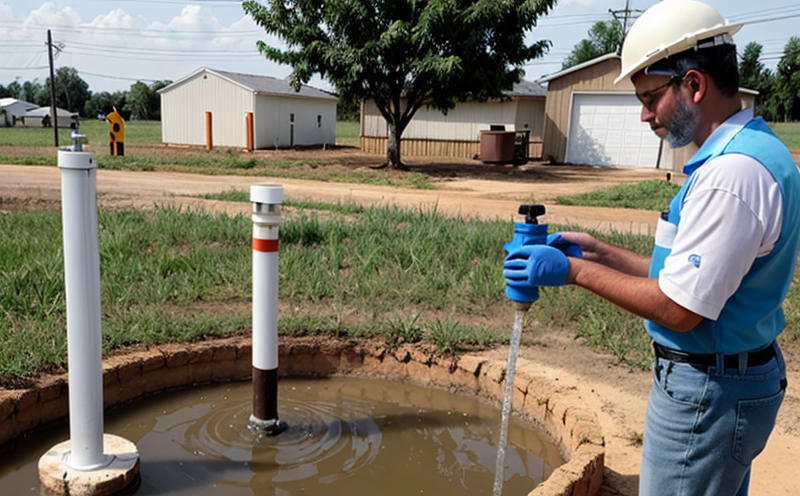EPA Method 552.1 Haloacetic Acids Testing in Groundwater
Groundwater is a critical resource for drinking water supplies and irrigation across the globe. Ensuring its quality is paramount, especially when it comes to halogenated compounds such as haloacetic acids (HAAs). The Environmental Protection Agency's EPA Method 552.1 provides standardized procedures for the analysis of HAAs in surface waters and groundwaters.
The testing procedure aims at measuring the concentration levels of five specific HAAs: dichloroacetic acid, trichloroacetic acid, monochloroacetic acid, monobromoacetic acid, and dibromoacetic acid. These compounds are by-products from chlorination processes used in water treatment plants to disinfect water supplies.
Groundwater contamination with HAAs can occur through various pathways including the leaching of agricultural chemicals into aquifers, industrial discharge, or improper waste disposal practices. The presence of these contaminants is a significant concern as they have been linked to potential health risks if ingested over prolonged periods.
The standard methodology involves several key steps: sample collection and preservation, extraction techniques, derivatization reactions, and ultimately, the analysis using high-performance liquid chromatography (HPLC) with ultraviolet-visible detection. Compliance officers responsible for monitoring water quality must ensure that these tests are conducted accurately to meet regulatory requirements.
Accurate measurement of HAAs is essential because even small concentrations can pose health risks. The EPA Method 552.1 specifies detailed procedures for sample handling, including the use of appropriate storage containers and temperature controls during transport from field sites back to laboratories. Proper preservation methods prevent degradation or transformation of the analytes before analysis.
The analytical technique used in this method relies on HPLC coupled with UV-Vis detection after derivatization. Derivatization converts less reactive HAAs into more readily detectable forms, enhancing sensitivity during the chromatographic separation process. This approach ensures reliable quantification even at very low concentrations which are often present in natural waters.
Compliance officers and quality managers play crucial roles in implementing this method within their organizations. They need to understand not only the technical aspects but also the broader implications of HAAs presence in groundwater resources. By adhering strictly to EPA Method 552.1, they help protect public health by ensuring that drinking water meets all necessary safety standards.
Understanding the significance of HAA contamination helps stakeholders make informed decisions regarding protective measures like alternative water sources or enhanced treatment processes. Regular monitoring according to this method is vital for maintaining compliance with national and international regulations related to groundwaters.
Applied Standards
The analysis of HAAs in groundwater follows the guidelines set forth by EPA Method 552.1. This standard ensures consistent results across different laboratories, providing a reliable basis for regulatory compliance and public health protection.
In addition to the EPA method, other relevant standards include ISO 9001:2015 for quality management systems, which emphasizes continuous improvement in laboratory operations; ASTM D4830-17 for soil and rock testing methods; and EN ISO/IEC 17025:2017 for general requirements for the competence of testing and calibration laboratories. These international standards contribute to ensuring accuracy, precision, and reliability in our analytical services.
The use of EPA Method 552.1 is particularly important because it aligns with U.S. Environmental Protection Agency regulations regarding drinking water safety. Compliance with this method helps ensure that groundwaters meet the established limits for HAAs under the Safe Drinking Water Act (SDWA).
To maintain high standards, our laboratory adheres strictly to all applicable international and national guidelines. This commitment ensures accurate results and fosters trust among clients who rely on us for critical testing services.
Quality and Reliability Assurance
At our laboratory, we prioritize quality assurance throughout every stage of the EPA Method 552.1 process to deliver reliable results that meet regulatory standards. Our approach begins with rigorous training for all personnel involved in collecting samples and performing analyses.
We follow strict protocols during sample preparation and storage to minimize potential contamination or alteration of analytes. This includes using clean glassware, appropriate container materials, and controlled temperature environments during transit back from field locations.
Our state-of-the-art analytical equipment supports precise measurements, providing consistent results across multiple batches. Regular calibration checks ensure that instruments operate correctly and consistently over time. Additionally, we participate in proficiency testing programs organized by recognized organizations to validate our performance against industry benchmarks.
Data interpretation plays a vital role in ensuring accurate reporting of findings based on EPA Method 552.1. Our team employs advanced statistical methods to analyze data and generate comprehensive reports that are easy for clients to understand. These reports not only provide quantitative results but also offer insights into broader implications for groundwater management.
By maintaining these rigorous quality control measures, we uphold the highest standards in our EPA Method 552.1 services, ensuring compliance with regulatory requirements while delivering valuable information to support decision-making processes related to groundwaters.
Use Cases and Application Examples
The primary application of EPA Method 552.1 lies in monitoring the quality of groundwater supplies, particularly those used for drinking water purposes. Compliance officers responsible for ensuring adherence to local, state, or federal regulations can rely on this method as part of their routine testing protocols.
R&D engineers involved in developing new treatment technologies may also find value in using EPA Method 552.1 during the validation stages of their projects. By measuring HAAs concentrations before and after applying various purification techniques, they can assess the effectiveness of different approaches.
For procurement teams dealing with sourcing raw materials or selecting suppliers for groundwaters used in manufacturing processes, EPA Method 552.1 offers a standardized way to evaluate potential sources based on their compliance status. This helps ensure consistent quality throughout supply chains and reduces risks associated with non-compliant products.
In addition to these professional applications, individuals concerned about the health impacts of HAAs in their local groundwater can seek out EPA Method 552.1 testing services from trusted laboratories like ours. These tests provide valuable data that citizens can use when advocating for stronger protections against contaminants.
The versatility and importance of EPA Method 552.1 cannot be overstated, making it an indispensable tool in safeguarding public health and environmental integrity worldwide.





